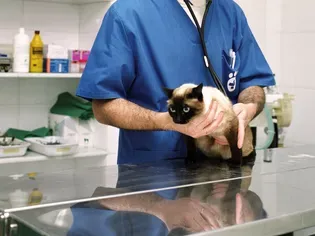Why Does My Cat Have a Belly Lump After Spay Surgery?
Updated on 04/26/24

Unlocking the Mystery: Why Does My Cat Have a Belly Lump After Spay Surgery?
After your beloved feline companion undergoes spaying surgery, it's natural to be concerned if you notice a lump on its belly. While it can be alarming, it's essential to understand that this lump is usually benign and part of the normal healing process. However, it's crucial to distinguish between harmless lumps and those that may require further attention.
Understanding Post-Spay Lump Types
* Suture Granuloma: This is the most common type of post-spay lump. It's a small, firm lump that forms around a suture site as the body reacts to foreign material.
* Seromas: These are fluid-filled sacs that develop due to fluid accumulation in the surgical site. They may be soft and movable or firm and fixed.
* Abscesses: While rare, they can occur if bacteria enter the surgical wound. Abscesses are usually painful, red, and filled with pus.
Examining the Nature of the Lump
To differentiate between these lump types, here are some observations you can make:
* Suture Granulomas: Typically small (pea-sized), firm, painless, and may resolve within weeks or months.
* Seromas: Soft, fluctuant, and may change size over time. They often disappear on their own.
* Abscesses: Painful, red or swollen, and may indicate infection.
Addressing Concerns and Seeking Professional Guidance
If you're uncertain about the type of lump your cat has or if it's accompanied by other symptoms, it's essential to consult your veterinarian. They will examine the lump, review your cat's medical history, and recommend appropriate treatment options.
When to Seek Immediate Attention:
While most post-spay lumps are harmless, seek immediate veterinary attention if you notice any of these concerning signs:
* Sudden onset: A lump that appears rapidly or overnight.
* Pain or discomfort: The cat shows signs of pain or discomfort when you touch the lump.
* Discharge: The lump is draining pus or fluid.
* Size or color changes: The lump significantly changes in size or color.
* Loss of appetite or lethargy: The cat shows signs of illness, such as decreased appetite or lethargy.
Managing and Monitoring Post-Spay Lumps
Most suture granulomas and seromas resolve on their own within a few weeks or months. However, if they persist or cause discomfort, your veterinarian may recommend treatment options such as:
* Warm compresses: Applying warm compresses to the lump can promote circulation and reduce inflammation.
* Antibiotics: In case of infection, antibiotics may be prescribed to clear the bacteria.
* Surgery: In rare cases, surgical removal of the lump may be necessary.
Preventing Post-Spay Lumps
While it's not always possible to prevent post-spay lumps, certain measures can minimize the risk:
* Choose an experienced veterinarian for the surgery.
* Follow post-operative care instructions carefully.
* Monitor your cat's incision site for any signs of infection.
* Avoid excessive licking or scratching of the incision.
Remember, early detection and appropriate treatment are key to ensuring your cat's well-being. If you have any concerns about a belly lump after spay surgery, don't hesitate to consult your veterinarian. They will guide you through the necessary steps to address the lump and provide peace of mind for both you and your feline friend.
Explore More Pets

Cat Behavior Problems
How to Stop Aggression in Kittens

Long-Haired Cat Breeds
Siberian Cat: Breed Profile, Characteristics, & Care

Cat Behavior Problems
How to Stop Kittens From Scratching and Biting

Long-Haired Cat Breeds
Turkish Angora: Cat Breed Profile, Characteristics & Care

Basic Training
How to Socialize Your Kitten

Short-Haired Cat Breeds
Cute Pictures & Facts About Calico Cats & Kittens

Litter Box Training
Training Your Kitten to Use the Litter Box

Long-Haired Cat Breeds
10 Fun Facts About White Cats